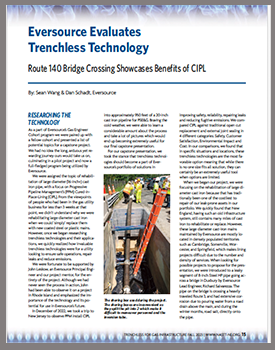INDUSTRY
APPLICATION
CLIENT
CROSS BORE PREVENTION INSPECTIONS
highlights
7,400 LEGACY AND NEW CONSTRUCTION INSPECTIONS
LOCATIONS: NORTHEAST REGION
DATE: 2017-2024
background & situation
A cross bore occurs when an existing underground pipeline or structure intersects with a second utility. Horizontal Directional Drilling (HDD), a widely used trenchless technology for installing gas pipelines, can be a factor for cross bore occurrences. During the HDD process, gas service lines are installed underground into building basements. The goal is to avoid intersections with pre-existing pipelines, usually sewer lines. Due to the nature of installing gas services, 100% accuracy cannot be guaranteed.
If utility lines intersect each other, it will compromise the integrity of either or both the utility and the underground structure. The intersection between a gas service line and a sewer pipe could lead to a gas line leak. While cross bores are uncommon, they pose a serious threat to public safety. Gas utilities proactively inspect both legacy and new construction installations to prevent the consequences of undetected cross bores. This is accomplished with a non-invasive inspection method. CCTV robotic cameras are used to provide a detailed assessment of the interior of sewer laterals.
National Grid and PPM have a longstanding partnership working on natural gas pipelines. In 2017, National Grid enlisted PPM to implement a large-scale CCTV Inspection program for sewer laterals, covering over 7,400 residences and commercial properties in the Northeast, including New York, Massachusetts, and Rhode Island.
Scope
Phase One of the project was to CCTV inspect sewer laterals through mainline inspections. PPM utilized a Lateral Launcher Robotic CCTV Camera, which includes a mainline camera as and additional home sewer lateral launch camera. PPM contacted specific local municipalities to request access to sewer mains and manholes. Permitting and traffic detail requirements were set. At each site, manholes were opened and the sewer main cleaned using a high-pressure water jetter, which blasts the walls of the pipe to clear existing debris.
After cleaning, the Lateral Launcher CCTV camera was inserted into the sewer main. The camera was operated from a console inside the PPM CCTV truck, with a technician monitoring the live video feed. The CCTV camera moved throughout the sewer main until laterals were located. The lateral in the street was matched with the address, the the depth of the pipe recorded. The cross bore inspections takes place within the home sewer lateral.
Phase Two involved push camera inspections inside homes. Multiple outreach methods were utilized to gain property owners' trust. When accessing homes wasn't possible, Phase Three required digging test pits to visually see the utilities to insure they were not crossing. The team used multiple tactics to assess the utilities’ locations, plot the potential locations where sewer lines could intersect, and then dig the test pits.
Challenges
Several challenges arose with irregular piping configurations, preventing camera access to sewer mains and laterals. The crew encountered situations with offset joints, sharp bends, and instances where debris or tree roots blocked the sewer mains and sewer laterals. Creative solutions were developed and implemented to overcome these obstacles in the field.
After the COVID pandemic, If the sewer lateral couldn't be accessed through the main, a second phase of the inspections involved push camera Inspections. These utilized a manual sewer push camera used from the basement of each property that is pushed towards the sewer main. To obtain permission to access the basements of the necessary homes, PPM's community outreach efforts utilized letters, door hangers, and personal home door knocking. It proved to be quite a challenge to gain resident's trust.
Some situations presented difficulties in finding and inspecting sewer laterals. The team persisted and found ways to capture data showing both gas and sewer line locations (relative to each other) to clear addresses of cross bore risks.
OUTCOMES & RESULTS
For each address, the PPM team collected all available data and facts about sewer lateral depth, house and yard grade changes, and the distance from the manhole to the lateral. This data was then cross-referenced with camera footage obtained by PPM. The complete data package, along with corresponding camera footage, was delivered to National Grid.
The "Clearing" process provides sufficient evidence that the inspection is complete, there is no risk of a cross bore, and the proof is documented for each address. The program is scheduled to be completed in 2024.
PPM has identified a small percentage of cross bores from the total inspections. When a cross bore is identified, the PPM team marks the affected area on the street and captures relevant photos. An immediate series of red alerts are communicated to the National Grid Project Manager and the appropriate town/municipality contacts. National Grid then promptly dispatches a crew to the site to excavate the affected pipes and remediate the risk.
About PPM: Progressive Pipeline Management is a full service contractor and team of highly skilled infrastructure renewal specialists. For over twenty one years, PPM has been improving the safety and longevity of pipeline infrastructure. PPM holds the exclusive licensee in North America for the Starline® Cured-in-place-lining. The team has specialized expertise including gas pipeline rehabilitation, restoration of damaged or leaking infrastructure, PIPES ACT compliance and trenchless technology, facilities pipe renewal and site services.
RELATED PROJECT PROFILES
UV CURED IN PLACE PIPE ROOF DRAIN RENEWAL
Remediation of roof drains in a 15 story building reduced costs and minimized disruption.
CLIENT
BUILDING OWNER
LOCATION
ATLANTIC CITY, NJ
YEAR
2022
36” STORMWATER UV CIPP DRAIN RENEWAL
A stormwater drain with leaking joints was renewed with cured-in-place-pipe.
CLIENT
BUILDING OWNER
LOCATION
MIDDLESEX, NJ
YEAR
2022










